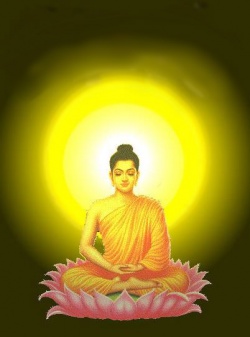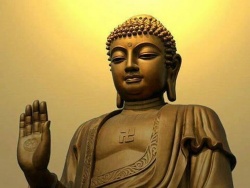Yogācāra Philosophy of Buddhism (Cittamatra)
The Kadampa tradition was a Tibetan Mahayana Buddhist school. Dromtönpa,a Tibetan lay master and the foremost disciple of the great Indian Buddhist Master Atisha (982-1054), founded it and passed three lineages to his disciples. The Kadampa were quite famous and respected for their proper and earnest Dharma practice. The most evident teachings of that tradition were the teachings on Bodhicitta (later these special presentations became known as Lojong (Blo-ljong)) and Lamrim (Stages of the Path) by Atisha.
Yogācāra in Tibet
Yogācāra was first transmitted to Tibet by Śāntarakṣita, and then later, again, by Atiśa. Yogācāra terminology (though not necessarily its view) is also employed by the Nyingmapa in attempting to describe the nondenumerable ultimate phœnomenon which is the intended endpoint of Dzogchen practice. Yogācāra is, therefore, an integral part of the history of Tibetan Buddhism. Although Je Tsongkhapa (whose reforms to Atisha’s Kadam tradition are generally considered the beginnings of what would come to be called the Gelug school within Tibet ) argued in favour of Yogācāra views (specifically regarding the existence and functioning of eight consciousnesses) early in his career, the prevailing Gelug view eventually came to hold Yogācāra views as a matter of interpretable meaning, therefore distinct from Mādhyamaka logic which was held to be of definitive meaning in terms of buddhist two truths doctrine. For their part, Jonang teachers including Taranatha held their own zhentong (or “other-voidness”) views expressed in terms of “Great Madhyamaka” to be ultimately definitive in meaning, in contrast to the circumstantially definitive rangtong (or “self-voidness”) philosophy of what they termed “General Madhyamaka”, comprising both Svatantrika and Prasangika Madhyamika. {The Jonang school was widely thought to have become extinct in the late 17th century at the hands of the Fifth Dalai Lama who forcibly annexed the Jonang monasteries to his Gelug school, declaring them heretical }
Stupa at Jomonang (U-Tsang, Lhatse,Tibet) completed 1333 (CE) by Dolpopa. Courtesy Jonang Foundation © 2007.
Current discussions between Tibetan scholars regarding the differences between zhentong (other-voidness) and rangtong (self-voidness, ) views may therefore appear similar to historical debates between Yogācāra and Mādhyamaka, but the specific distinctions have, in fact, evolved much further. Although later Tibetan views may be said to have evolved from the earlier Indian positions, the distinctions between the views have became increasingly subtle, especially as Yogācāra has evolved to incorporate the Mādhyamaka view of the ultimate. Ju Mipham, the 19th century rime movement commentator, wrote in his commentary on Śāntarakṣita’s synthesis, that the ultimate view in both schools is the same, and that each path leads to the same ultimate state of abiding.
8 CONSCIOUSNESS
http://en.wikipedia.org/wiki/Eight_Consciousnesses
The six consciousnesses
Visual (or eye) consciousness (Skt. cakṣur-vijñana; Tib. མིག་གི་རྣམ་ཤེས་, mig gi rnam shes)
Auditory (or ear) consciousness (Skt. śrotra-vijñana; Tib. རྣ་བའི་རྣམ་ཤེས་, rna ba’i rnam shes)
Olfactory (or nose) consciousness (Skt. ghrāṇa-vijñana; Tib. སྣའི་རྣམ་ཤེས་, sna’i rnam shes)
Gustatory (or tongue) consciousness (Skt. jihva-vijñana; Tib. ལྕེའི་རྣམ་ཤེས་, lce’i rnam shes)
Tactile (or body) consciousness (Skt. kāya-vijñana; Tib. ལུས་ཀྱི་རྣམ་ཤེས་, lus kyi rnam shes)
Mental (or mind) consciousness (Skt. mano-vijñana; Tib. ཡིད་ཀྱི་རྣམ་ཤེས་, yid kyi rnam shes)
The seventh and eighth consciousness
To the six consciousnesses mentioned in the Abhidharma texts of the basic vehicle are added:
7. Defiled mental consciousness or emotional consciousness (Skt. kliṣṭamanas; Tib. ཉོན་ཡིད་, Wyl. nyon yid) and
8. All-ground consciousness (Skt. ālaya vijñāna; Tib. ཀུན་གཞི་རྣམ་ཤེས་, kunshyi namshé; Wyl. kun gzhi rnam shes).

